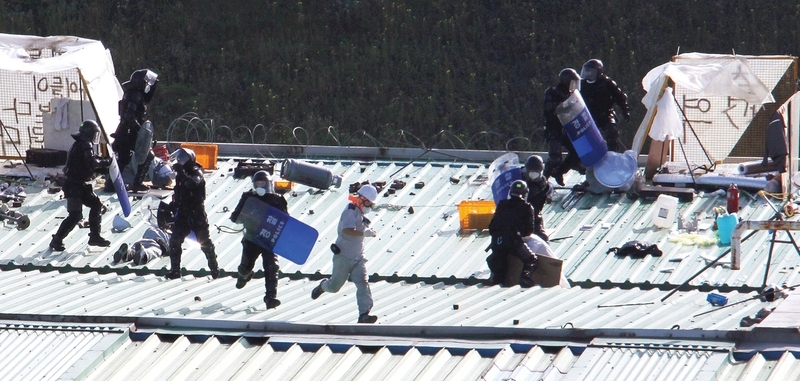 |
|
Kim Seon-dong, a former worker for SsangYong Motor, was participating in a strike in 2009 when police entered the factory facilities and violently suppressed the strike. Kim and his colleagues endured violent suppression with antiterrorist weapons such as Tasers and multipurpose launchers. In the above photo, Kim calls for the punishment of those responsible in front of the National Police Agency in Seoul on Aug. 28. (Kim Jung-hyo, staff photographer)
|
Expiration of statute of limitation exempts punishment for illegal suppression of labor strike
As rain poured down on the headquarters of South Korea’s National Police Agency (NPA), workers terminated from SsangYong Motor shouted slogans. “They were killed by Lee Myung-bak!” “Punish those responsible for state violence!” The slogans were part of a press conference held in front of the NPA headquarters, in Seoul’s Seodaemun District, calling for the prosecution of former president Lee Myung-bak and former Gyeonggi Province Police Agency Commissioner Cho Hyun-oh. The press conference was organized by the SsangYong Motor chapter of the Korean Metal Workers’ Union, associated with the Korean Confederation of Trade Unions (KCTU), and the SsangYong Motor Nationwide Action Committee after a fact-finding commission responsible for investigating cases of human rights abuses by the NPA concluded on Aug. 28 that the police’s crackdown on the SsangYong Motor union strike in 2009 had received final approval from the Blue House under former president Lee Myung-bak. The participants in the press conference demanded that Lee should be held legally responsible for the police raid, since he was the one who gave it the final approval. “Lee Myung-bak, the police, the prosecutors, the Ministry of Labor and the company rushed to carry out a joint operation that violently trampled on workers’ rights. We know that the Blue House gave the final approval, and the president at the time was Lee,” said Lee Sang-jin, vice chair of the KCTU. “Since the statute of limitations is over, a special law should be passed to hold them responsible,” said Kim Deuk-jong, chair of the SsangYong Motor chapter of the Korean Metal Workers’ Union. “I had to stand by and watch my colleagues being beaten and their lives endangered by the police commandos. That’s a pain I’ll never forget, even if I’m reinstated to my job. I really want to resolve this injustice,” said Kim Seon-dong, through his tears. Kim, one of the terminated workers, was camped out on the roof of the SsangYong Motor assembly facility when the police forced their way in. “In July 2009, hired thugs beat me with steel pipes that left bruises all over my body. My ear was shot off by a slingshot round. The people who beat me haven’t been punished. They need to pay the price for their crimes,” said Kang Hwang-ju, another terminated worker. Police mobilized antiterrorist manpower and weapons According to the commission’s findings, police helicopters sprayed 200,000l of water mixed with tear gas – the main ingredient of which is a class-two carcinogenic – at the workers. There was also an attempt to force the workers to disperse using the blast of air from low-flying helicopters. Weaponry designated as antiterrorist equipment – including Tasers and multipurpose launchers – were also used against the workers. Furthermore, evidence has emerged that when the police commando team (originally organized for use in antiterrorist operations) entered the factory, it carried out acts of violence intended to avenge colleagues injured during strike suppression. The commission concluded that such police behavior was illegal, since it violated the Act on the Performance of Duties by Police Officers and regulations about using hazardous police equipment. But the police can’t be held legally responsible for the illegal operation, since the statute of limitations has expired for all these crimes. The participants in the assembly on Tuesday also said that another investigation should be held to get to the bottom of the suppression of the SsangYong strike, placing a particular emphasis on more than a hundred documents suspected of showing SsangYong Motor’s union busting.
 |
|
Police dressed in riot gear suppress a union strike at a SsangYong Motor facility on Aug. 8, 2009. (provided by the SsangYong Motor chapter of the Korean Metal Workers’ Union)
|
 |
|
Police violently suppress a labor strike at a SsangYong Motor facility in a presidentially approved operation involving helicopters and antiterrorist weapons on Aug. 4-5, 2009. (Ryu Woo-jong, staff photographer)
|







